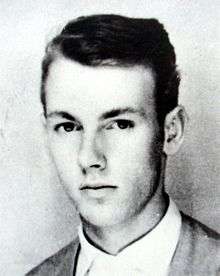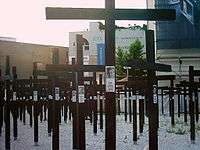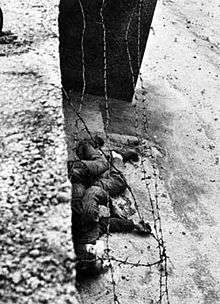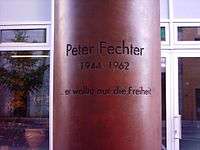Killing of Peter Fechter
| Peter Fechter | |
|---|---|
 | |
| Born |
14 January 1944 Berlin |
| Died |
17 August 1962 (aged 18) Zimmerstrasse near Friedrich/Zimmerstrasse border crossing Checkpoint Charlie |
| Cause of death | Shot by a guard without warning whilst attempting to leave East Berlin |
| Body discovered |
Zimmerstrasse Death Strip 52°30′28″N 13°23′37″E / 52.5078°N 13.3935°E |
| Monuments | Devin Hernandez memorial |
| Known for | One of the first and youngest fatalities and denied medical aid at the Berlin Wall |
Peter Fechter (14 January 1944 – 17 August 1962) was a German bricklayer from Berlin in what became East Germany in 1945. He was 18 when he became one of the first victims of the Berlin Wall's East German border guards while trying to cross over to what was then West Berlin.
Background

After World War II, Germany was governed jointly by an Allied Control Council consisting of the victorious Allied nations — The United Kingdom, the United States, the Soviet Union and France. Governmental decisions had to be unanimously approved by all four Allies. Germany was divided into Allied Occupation Zones to be administered directly by the military of each Allied state. The German capital, Berlin, was itself specially divided into four zones, one for each Ally, due to its importance.
As the Cold War escalated, the Potsdam Agreement on managing Germany disintegrated, and the Allied Control Council became ineffective. The country was de facto divided into West Germany and East Germany, corresponding to the areas occupied by the western Allies and the Soviet Union, respectively. Berlin, which lay entirely within the territory of the new East, was divided into West Berlin and East Berlin. From 1945, East Germany's civilian local governments were dominated by social democrats, but in 1949, the Soviets formed a government under the Socialist Unity Party of Germany (SED) led by Walter Ulbricht. Despite tensions, open borders were more or less maintained within Berlin itself for some time. But the increasing flight of many refugees from East Berlin to the West prompted the Communist government to build the Berlin Wall, beginning in 1961. Though officially billed by the government as an "Anti-Fascist Protection Wall," ostensibly to keep lingering elements of the former Nazi regime harbored by the West out of East Berlin, the wall, in contrast to usual border fortifications, was primarily designed to prevent East German citizens from escaping into West Berlin and seeking political asylum.
Death

About one year after the construction of the wall, Fechter attempted to flee from East Germany together with his friend Helmut Kulbeik. The plan was to hide in a carpenter's workshop near the wall in Zimmerstrasse and, after observing the border guards from there, to jump out of a window into the "death-strip" (a strip running between the main wall and a parallel fence which they had recently started to construct), run across it, and climb over the two metre (6.5 ft) wall topped with barbed wire into the Kreuzberg district of West Berlin near Checkpoint Charlie.
When both reached the wall, guards fired at them. Although Kulbeik succeeded in crossing the wall, Fechter, still on the wall, was shot in the pelvis in plain view of hundreds of witnesses. He fell back into the death-strip on the Eastern side, where he remained in view of Western onlookers, including journalists. Despite his screams, he received no medical assistance from the East side, and could not be tended to by those on the West side. Western police threw him bandages, which he could not reach. He bled to death after approximately one hour. As a result of his death, hundreds in West Berlin formed a spontaneous demonstration, shouting "Murderers!" at the border guards.
The lack of medical assistance for Peter Fechter was attributed to mutual fear: western bystanders were apparently prevented at gunpoint from assisting him, although according to a report in Time magazine, a U.S. second lieutenant on the scene received specific orders from the US Commandant in West Berlin to stand firm and do nothing. It also emerged during the trial that any aid attempt from the West had indeed been made impossible, but according to a report from forensic pathologist Otto Prokop, "Fechter had no chance of survival. The shot in the right hip had caused severe internal injuries." Likewise the head of the East German border platoon stated that he was afraid to intervene, because of an incident just three days earlier when an East German soldier Rudi Arnstadt had probably been shot by a Western federal policeman. Nonetheless, the East German border soldiers did retrieve Peter Fechter's body an hour after he had died.
Trial
In March 1997 two former East German guards, Rolf Friedrich and Erich Schreiber, faced manslaughter charges for Fechter's death, and admitted to his shooting. They were both convicted, and sentenced to 20 and 21 months' imprisonment on probation. Due to a lack of conclusive evidence, the court was unable to determine which of three gunmen (one of whom had already died) had fired the fatal bullet.
After pleading guilty to the crime, during sentencing, both guards apologized for killing Fechter: adding that they would forever live in the guilt of their crime. After serving 4-5 months in jail, the rest of their terms were vacated due to the court believing that the guards were truly remorseful.
Commemoration

A cross was placed on the western side near the spot where Fechter was shot and bled to death. At the invitation of Willy Brandt, the then mayor of West Berlin, the Yale Russian Chorus sang a German translation of Mozart's Ave Verum Corpus near the site in the week following the shooting. On the first anniversary, a wreath was placed there by Willy Brandt and US major general James Polk. The story of Peter Fechter was the headline of American news magazine Time in August 1962.[1] In this article was used the noun "Wall of Shame" (Mauer der Schande), and this became a synonym for the wall.[2]

After German reunification in 1990, the Peter-Fechter-Stelle memorial was constructed on Zimmerstrasse, at the precise spot where he had died on the Eastern side, and this has been a focal point for some of the commemorations regarding the wall.
The shooting has also been the subject of documentaries on German television. Cornelius Ryan dedicated his book The Last Battle to the memory of Fechter. Composer Aulis Sallinen wrote an orchestral work Mauermusik to commemorate Fechter. In 2007, artist Mark Gubb was commissioned by the Institute of Contemporary Arts to create a performance[3] based on the death of Peter Fechter. The performance was a one-hour live piece that was later recorded and screened at the ICA with a discussion panel at the end consisting of the artist, and actor Dominik Danielewicz who played the part of Peter Fechter. The 1972 ballad Libre ("Free") - a recording famous in all Ibero-America - by Spanish singer Nino Bravo, remembers this event.[4] In 2012 Canadian playwright Jordan Tannahill's play 'Peter Fechter: 59 Minutes', a poetic re-imagining of the final hour of Fechter's life, was produced in Canada and Berlin (Playwrights Canada Press, 2013, ISBN 9781770911949).
Literature
- Christine Brecht: Peter Fechter, in: Die Todesopfer an der Berliner Mauer 1961–1989. Ein biographisches Handbuch. Links, Berlin 2009, ISBN 978-3-86153-517-1, S. 101–104.
- Lars-Broder Keil, Sven Felix Kellerhoff; Thomas Schmid (Hrsg.): Mord an der Mauer. Der Fall Peter Fechter. Mit einem Geleitwort von Klaus Wowereit. Quadriga, Köln 2012, ISBN 978-3-86995-042-6.
See also
![]() Media related to Peter Fechter at Wikimedia Commons
Media related to Peter Fechter at Wikimedia Commons
References
- ↑ time.com
- ↑ time.com
- ↑ The Death of Peter Fechter film and discussion
- ↑ "Libre: la triste historia detrás de una exitosa canción" (in Spanish). Retrieved 2016-08-15.
External links
- The Wall Comes Tumbling Down, excerpt from a biography of Leonard Bernstein at the Wayback Machine (archived June 5, 2008)
- Berlin Wall at Zimmerstrasse, Photos near the location of Fechter's death, taken in 1961
- ICA Performance, the performance and screening of the "Death of Peter Fechter"
